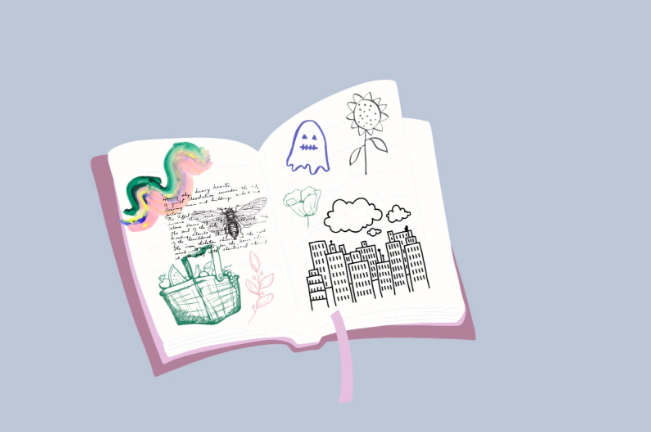Messiness and imperfection are the keystones of this craft

Mo, an artist and student at the Toronto Art Therapy Institute, flipped their camera around during a Zoom event on Friday so that attendees could see their workspace. There was a pot of ink, magazine snippets and gel pens surrounding a black, hardcover book that laid open flat in the middle of the screen. Mo encouraged watchers to create with them, or, simply relax and enjoy their creative process.
“Even just watching you is so therapeutic,” one attendee said. The online event was in collaboration with the Faculty of Communication and Design (FCAD) Wellness Week.
Mo, who identifies with their first name only, began art journaling during their time in art therapy school. They were able to work in their own space for one class a week and Mo took the opportunity to perfect their craft of art journaling.
Flipping through their art journal, the pages are thick with dried ink and paint and the journal looks worn. Mo uses blackout poetry, beading, stitching and collaging throughout their journal, sometimes including photos of people that are important to them. As an Indigenous person, creative spreads about land and ancestry remain a constant throughout their art.
Mo has been using art as their voice since they were little and recalls making art about traumatic experiences growing up.
According to research stated in The Connection Between Art, Healing, and Public Health, “Art helps people express experiences that are too difficult to put into words.”
Mo is neurodivergent and since working through their diagnosis, they have come to value the idea of imperfectionism in their art. They mention that the process of getting messy in their journal is “good for their brain.”
“It’s freeing,” Mo said, after smearing black ink on the page and shutting their journal closed to create a Rorschach effect. “Like, I don’t know what I’m doing but I don’t care.”
Art journaling helps Mo voice their feelings without any pressure or expectations.
“For many people, the pandemic has severely limited or even eliminated safe spaces for reflection, or expression of thought in a non-judgemental environment,” Zanab Jafry, a specialist at the Office of Sexual Violence Support and Education, said. She explained that experiences like journaling can provide a “self-made healing space” to combat that.
In response to whether or not art journaling has positively impacted their mental health, Mo said, “Oh, hell yeah.”
Mo said art journaling allows them to take what they are feeling and externalize it, and not take it on as their complete identity. “To be able to make something outside of myself and have a different perspective on how I see myself has been really transformative,” he said.
Creating art also reduces stress in adults and instead induces positive mental states, according to a study by the Journal of the American Art Therapy Association.
Creativity bolsters mental health by letting people take a break from the constant structure and guidelines that control the content they are making, like in class or at work, Jafry said.
She also said the process allows people to have complete agency over their creation, “for people who lack agency in other parts of their lives, creative projects can build confidence as they can decide how or what to create.”
